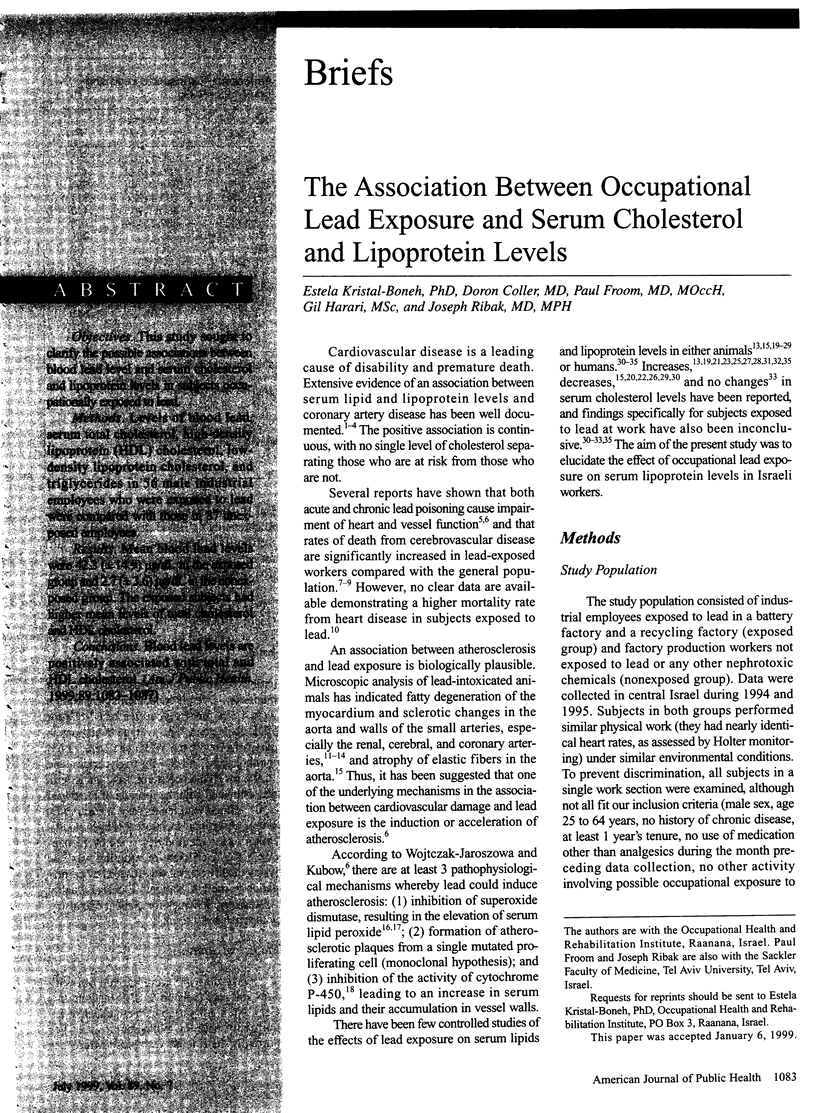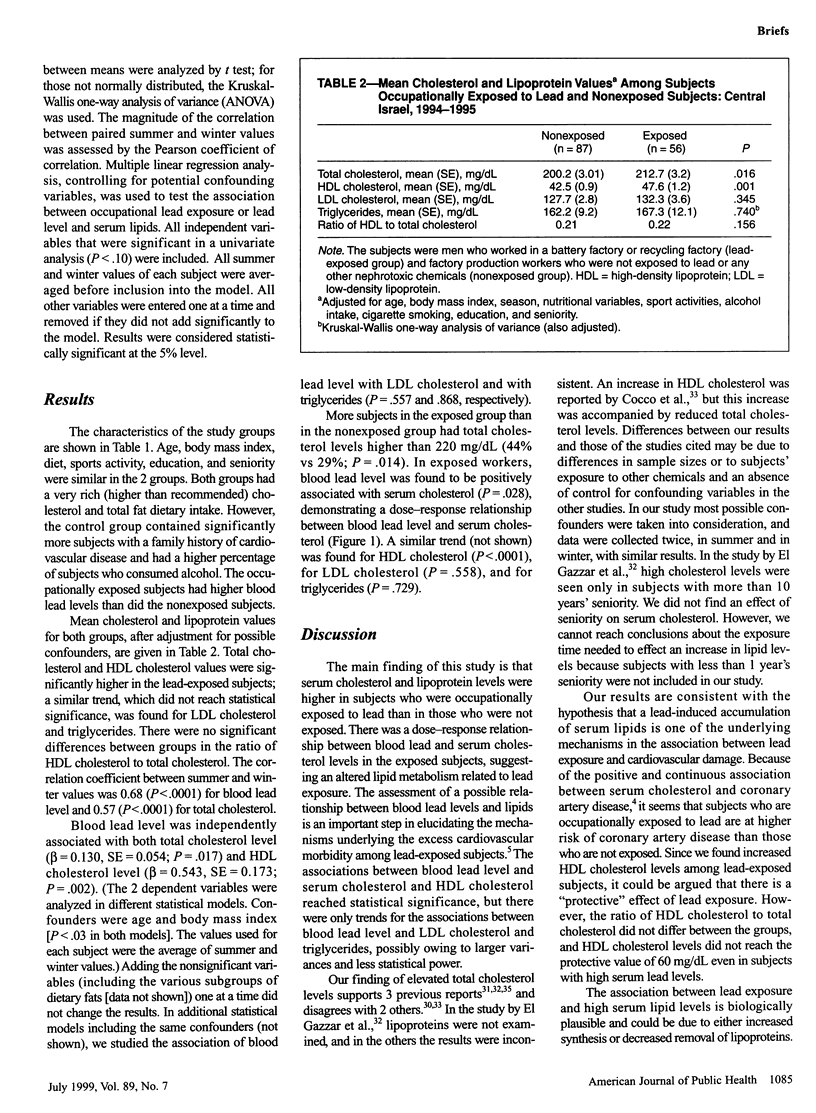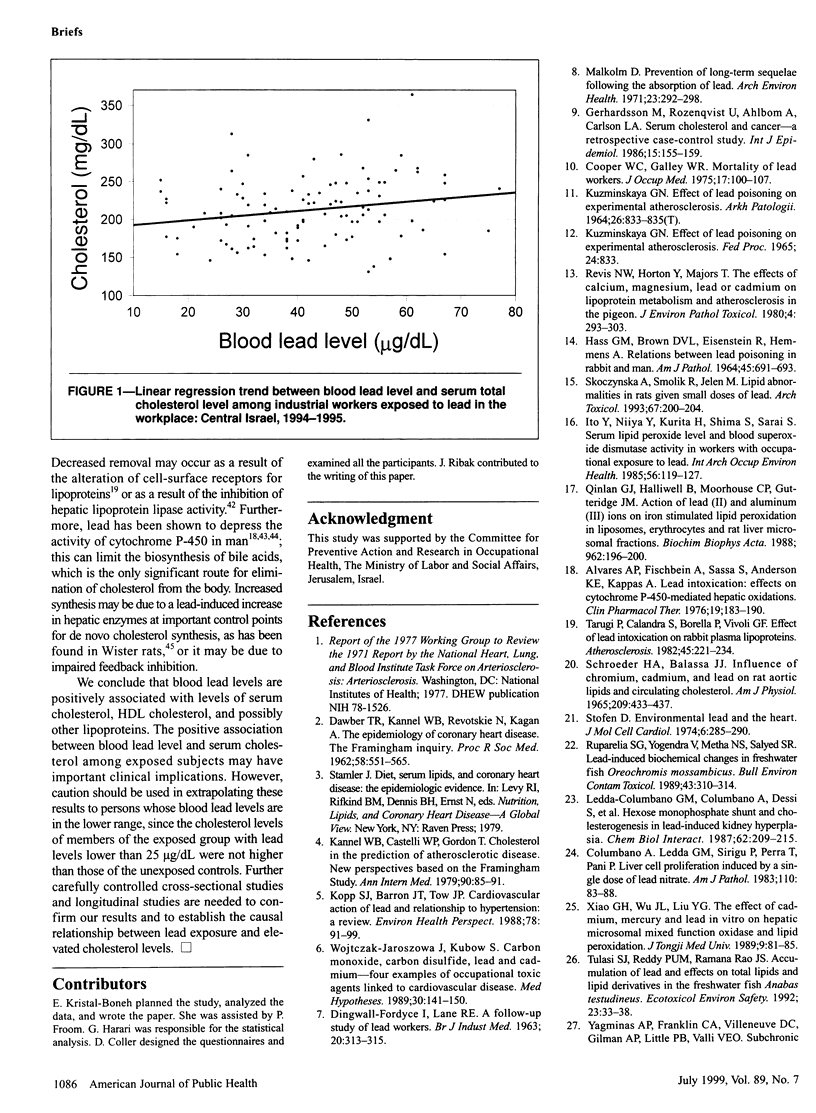Abstract
OBJECTIVES: This study sought to clarify the possible associations between blood lead level and serum cholesterol and lipoprotein levels in subjects occupationally exposed to lead. METHODS: Levels of blood lead, serum total cholesterol, high-density lipoprotein (HDL) cholesterol, low-density lipoprotein cholesterol, and triglycerides in 56 male industrial employees who were exposed to lead were compared with those in 87 unexposed employees. RESULTS: Mean blood lead levels were 42.3 (+/- 14.9) micrograms/dL in the exposed group and 2.7 (+/- 3.6) micrograms/dL in the nonexposed group. The exposed subjects had higher mean levels of total cholesterol and HDL cholesterol. CONCLUSIONS: Blood lead levels are positively associated with total and HDL cholesterol.
Full text
PDF




Selected References
These references are in PubMed. This may not be the complete list of references from this article.
- Allain C. C., Poon L. S., Chan C. S., Richmond W., Fu P. C. Enzymatic determination of total serum cholesterol. Clin Chem. 1974 Apr;20(4):470–475. [PubMed] [Google Scholar]
- Alvares A. P., Fischbein A., Sassa S., Anderson K. E., Kappas A. Lead intoxication: effects on cytochrome P-450-mediated hepatic oxidations. Clin Pharmacol Ther. 1976 Feb;19(2):183–190. doi: 10.1002/cpt1976192183. [DOI] [PubMed] [Google Scholar]
- Alvares A. P., Kapelner S., Sassa S., Kappas A. Drug metabolism in normal children, lead-poisoned children, and normal adults. Clin Pharmacol Ther. 1975 Feb;17(2):179–183. doi: 10.1002/cpt1975172179. [DOI] [PubMed] [Google Scholar]
- Chajek-Shaul T., Friedman G., Stein O., Shiloni E., Etienne J., Stein Y. Mechanism of the hypertriglyceridemia induced by tumor necrosis factor administration to rats. Biochim Biophys Acta. 1989 Feb 20;1001(3):316–324. doi: 10.1016/0005-2760(89)90116-1. [DOI] [PubMed] [Google Scholar]
- Cocco P. L., Cocco E., Anni M. S., Flore C., Melis A., Salis S. Occupational exposure to lead and blood cholesterol in glucose-6-phosphate dehydrogenase deficient and normal subjects. Res Commun Chem Pathol Pharmacol. 1991 Apr;72(1):81–95. [PubMed] [Google Scholar]
- Cocco P., Salis S., Anni M., Cocco M. E., Flore C., Ibba A. Effects of short-term occupational exposure to lead on erythrocyte glucose-6-phosphate dehydrogenase activity and serum cholesterol. J Appl Toxicol. 1995 Sep-Oct;15(5):375–378. doi: 10.1002/jat.2550150506. [DOI] [PubMed] [Google Scholar]
- Columbano A., Ledda G. M., Sirigu P., Perra T., Pani P. Liver cell proliferation induced by a single dose of lead nitrate. Am J Pathol. 1983 Jan;110(1):83–88. [PMC free article] [PubMed] [Google Scholar]
- Cooper W. C., Gaffey W. R. Mortality of lead workers. J Occup Med. 1975 Feb;17(2):100–107. doi: 10.1097/00043764-197502000-00012. [DOI] [PubMed] [Google Scholar]
- DINGWALL-FORDYCE I., LANE R. E. A FOLLOW-UP STUDY OF LEAD WORKERS. Br J Ind Med. 1963 Oct;20:313–315. doi: 10.1136/oem.20.4.313. [DOI] [PMC free article] [PubMed] [Google Scholar]
- Dessì S., Batetta B., Laconi E., Ennas C., Pani P. Hepatic cholesterol in lead nitrate induced liver hyperplasia. Chem Biol Interact. 1984 Mar;48(3):271–279. doi: 10.1016/0009-2797(84)90140-6. [DOI] [PubMed] [Google Scholar]
- Dessí S., Batetta B., Carrucciu A., Pulisci D., Laconi S., Fadda A. M., Anchisi C., Pani P. Variations of serum lipoproteins during cell proliferation induced by lead nitrate. Exp Mol Pathol. 1989 Oct;51(2):97–102. doi: 10.1016/0014-4800(89)90010-5. [DOI] [PubMed] [Google Scholar]
- Fernandez F. J. Micromethod for lead determination in whole blood by atomic absorption, with use of the graphite furnace. Clin Chem. 1975 Apr;21(4):558–561. [PubMed] [Google Scholar]
- Friedewald W. T., Levy R. I., Fredrickson D. S. Estimation of the concentration of low-density lipoprotein cholesterol in plasma, without use of the preparative ultracentrifuge. Clin Chem. 1972 Jun;18(6):499–502. [PubMed] [Google Scholar]
- Gatagonova T. M. Osobennosti lipidnogo sostava syvorotki krovi u rabochikh, zaniatykh v proizvodstve svintsa. Med Tr Prom Ekol. 1994;(12):17–21. [PubMed] [Google Scholar]
- Gerhardsson M., Rosenqvist U., Ahlbom A., Carlson L. A. Serum cholesterol and cancer--a retrospective case-control study. Int J Epidemiol. 1986 Jun;15(2):155–159. doi: 10.1093/ije/15.2.155. [DOI] [PubMed] [Google Scholar]
- HASS G. M., BROWN D. V., EISENSTEIN R., HEMMENS A. RELATIONS BETWEEN LEAD POISONING IN RABBIT AND MAN. Am J Pathol. 1964 Nov;45:691–727. [PMC free article] [PubMed] [Google Scholar]
- Ito Y., Niiya Y., Kurita H., Shima S., Sarai S. Serum lipid peroxide level and blood superoxide dismutase activity in workers with occupational exposure to lead. Int Arch Occup Environ Health. 1985;56(2):119–127. doi: 10.1007/BF00379383. [DOI] [PubMed] [Google Scholar]
- Kannel W. B., Castelli W. P., Gordon T. Cholesterol in the prediction of atherosclerotic disease. New perspectives based on the Framingham study. Ann Intern Med. 1979 Jan;90(1):85–91. doi: 10.7326/0003-4819-90-1-85. [DOI] [PubMed] [Google Scholar]
- Khan M. Z., Szarek J., Krasnodebska-Depta A., Koncicki A. Effects of concurrent administration of lead and selenium on some haematological and biochemical parameters of broiler chickens. Acta Vet Hung. 1993;41(1-2):123–137. [PubMed] [Google Scholar]
- Kopp S. J., Barron J. T., Tow J. P. Cardiovascular actions of lead and relationship to hypertension: a review. Environ Health Perspect. 1988 Jun;78:91–99. doi: 10.1289/ehp.887891. [DOI] [PMC free article] [PubMed] [Google Scholar]
- Kuz'minskaya G. N. Effect of lead poisoning on experimental atherosclerosis. Fed Proc Transl Suppl. 1965 Sep-Oct;24(5):833–835. [PubMed] [Google Scholar]
- Ledda-Columbano G. M., Columbano A., Dessi S., Coni P., Chiodino C., Faa G., Pani P. Hexose monophosphate shunt and cholesterogenesis in lead-induced kidney hyperplasia. Chem Biol Interact. 1987;62(3):209–215. doi: 10.1016/0009-2797(87)90022-6. [DOI] [PubMed] [Google Scholar]
- Malcolm D. Prevention of long-term sequelae following the absorption of lead. Arch Environ Health. 1971 Oct;23(4):292–298. doi: 10.1080/00039896.1971.10666004. [DOI] [PubMed] [Google Scholar]
- Meredith P. A., Campbell B. C., Moore M. R., Goldberg A. The effects of industrial lead poisoning on cytochrome P450 mediated phenazone (antipyrine) hydroxylation. Eur J Clin Pharmacol. 1977 Nov 14;12(3):235–239. doi: 10.1007/BF00609867. [DOI] [PubMed] [Google Scholar]
- Morisi G., Menditto A., Spagnolo A., Patriarca M., Menotti A. Association of selected social, environmental and constitutional factors to blood lead levels in men aged 55-75 years. Sci Total Environ. 1992 Sep 25;126(3):209–229. doi: 10.1016/0048-9697(92)90198-2. [DOI] [PubMed] [Google Scholar]
- Quinlan G. J., Halliwell B., Moorhouse C. P., Gutteridge J. M. Action of lead(II) and aluminium (III) ions on iron-stimulated lipid peroxidation in liposomes, erythrocytes and rat liver microsomal fractions. Biochim Biophys Acta. 1988 Sep 23;962(2):196–200. doi: 10.1016/0005-2760(88)90159-2. [DOI] [PubMed] [Google Scholar]
- Revis N. W., Major T. C., Horton C. Y. The effects of calcium, magnesium, lead, or cadmium on lipoprotein metabolism and atherosclerosis in the pigeon. J Environ Pathol Toxicol. 1980 Sep;4(2-3):293–303. [PubMed] [Google Scholar]
- Ruparelia S. G., Verma Y., Mehta N. S., Salyed S. R. Lead-induced biochemical changes in freshwater fish Oreochromis mossambicus. Bull Environ Contam Toxicol. 1989 Aug;43(2):310–314. doi: 10.1007/BF01701763. [DOI] [PubMed] [Google Scholar]
- SCHROEDER H. A., BALASSA J. J. INFLUENCE OF CHROMIUM, CADMIUM, AND LEAD ON RAT AORTIC LIPIDS AND CIRCULATING CHOLESTEROL. Am J Physiol. 1965 Aug;209:433–437. doi: 10.1152/ajplegacy.1965.209.2.433. [DOI] [PubMed] [Google Scholar]
- Skoczyńska A., Smolik R., Jeleń M. Lipid abnormalities in rats given small doses of lead. Arch Toxicol. 1993;67(3):200–204. doi: 10.1007/BF01973308. [DOI] [PubMed] [Google Scholar]
- Stöfen D. Letter: Environmental lead and the heart. J Mol Cell Cardiol. 1974 Jun;6(3):285–290. doi: 10.1016/0022-2828(74)90059-5. [DOI] [PubMed] [Google Scholar]
- Tarugi P., Calandra S., Borella P., Vivoli G. F. Heavy metals and experimental atherosclerosis. Effect of lead intoxication on rabbit plasma lipoproteins. Atherosclerosis. 1982 Nov;45(2):221–234. doi: 10.1016/0021-9150(82)90140-x. [DOI] [PubMed] [Google Scholar]
- Tulasi S. J., Reddy P. U., Rao J. V. Accumulation of lead and effects on total lipids and lipid derivatives in the freshwater fish Anabas testudineus (Bloch). Ecotoxicol Environ Saf. 1992 Feb;23(1):33–38. doi: 10.1016/0147-6513(92)90019-y. [DOI] [PubMed] [Google Scholar]
- Wojtczak-Jaroszowa J., Kubow S. Carbon monoxide, carbon disulfide, lead and cadmium--four examples of occupational toxic agents linked to cardiovascular disease. Med Hypotheses. 1989 Oct;30(2):141–150. doi: 10.1016/0306-9877(89)90101-1. [DOI] [PubMed] [Google Scholar]
- Xiao G. H., Wu J. L., Liu Y. G. The effects of cadmium, mercury and lead in vitro on hepatic microsomal mixed function oxidase and lipid peroxidation. J Tongji Med Univ. 1989;9(2):81–85. doi: 10.1007/BF02908931. [DOI] [PubMed] [Google Scholar]
- el-Gazzar R. M., el-Hefny S. A., Noweir K. H., Shamy M. Y. Study of the lipoprotein pattern among workers exposed to lead. J Egypt Public Health Assoc. 1989;64(5-6):571–585. [PubMed] [Google Scholar]


